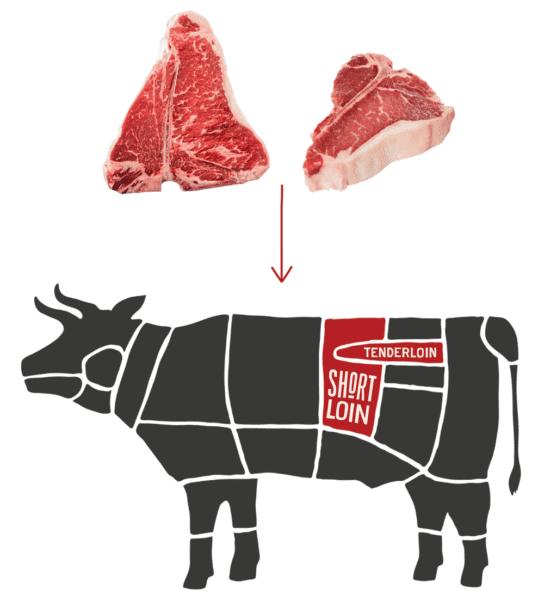T-Bone and Porterhouse
beef cuts explained
T-Bone and Porterhouse

What Is It?
The Porterhouse and T-Bone steaks, originating from the same primal cut, bear a striking resemblance to one another. Often referred to as the T-Bone’s formidable big brother, the Porterhouse steak is carved from the meeting point of the tenderloin (think filet mignon) and the top loin (think New York strip). This majestic steak embodies the finest attributes of both the filet and the strip, making it an impressive, sizable cut that can easily satisfy the appetites of two or more individuals. It reigns supreme in the realm of steakhouses, with a thickness of around 2 inches and a weight ranging from 2 to 3 pounds.
But what sets the Porterhouse apart from the T-Bone? Essentially, they are the same cut, with the distinction lying in the size of the filet. A Porterhouse boasts a larger filet, measuring at least 1.25 inches, whereas anything below this threshold falls into the T-Bone category.
how to prepare:
For a luscious, golden-brown sear, consider employing a cast-iron skillet. Feeling adventurous and ready to take your cooking skills to the next level? Try your hand at reverse searing using the following steps:
- Remove steak from refrigerator and bring to room temperature.
- Preheat your oven to 275°F and position the steak on a wire rack placed over a baking sheet.
-
Set the baking sheet on the center rack of the preheated oven and allow the steak to cook until the internal temperature registers 15°F lower than
your desired final temperature.
- Remove the steak from the oven and let it rest for 5 minutes, lightly covered with foil.
- Heat a heavy skillet or cast-iron skillet over high heat until it becomes very hot, which usually takes about 5 minutes. Optimal searing results are achieved with a sizzling-hot skillet.
- Introduce a generous knob of butter or a high smoke point oil like avocado oil, canola oil, or grapeseed oil to the skillet. Sear the steaks for 1-2 minutes on each side. When you reach your desired degree of doneness, remove from heat. The target internal temperature for a medium-rare steak is 135°F, while medium calls for 145°F.
- Transfer the cooked steak to a cutting board or a warm plate and let it rest for about 5-10 minutes. This resting period allows the juices to redistribute, resulting in a more tender and flavorful steak.
The searing process will imbue your steaks with a rich, golden-brown color and elevate their flavor to match that of traditionally grilled steaks.
*Serve immediately*. Unlike other steak-cooking methods, the low heat used in the reverse searing technique doesn’t draw the meat juices to the surface, eliminating the need for additional resting time.
How To Pair:
To complete your culinary masterpiece, consider pairing this magnificent cut with a California Syrah or an Italian Barolo. These flavorful and aromatic wine options harmonize beautifully with the lean and tender T-Bone/Porterhouse, enhancing your dining experience to new heights.
Try It!
We encourage you to indulge in the regal Porterhouse steak, relishing the combination of tenderloin and top loin flavors in one monumental cut. Impress your guests or treat yourself to a truly exceptional meal that showcases the artistry of steak preparation. Visit the butcher counter at your local Milam’s in Miami take this experience home!
